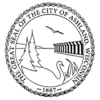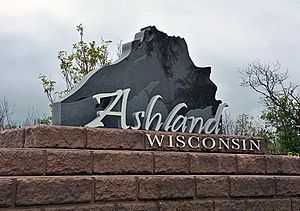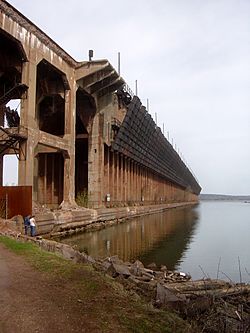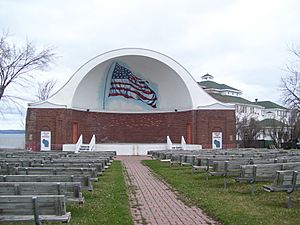Ashland, Wisconsin facts for kids
Quick facts for kids
Ashland, Wisconsin
|
||
|---|---|---|
|
City
|
||
|
||
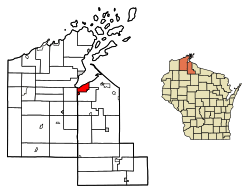
Location of Ashland in Ashland County
and Bayfield County, Wisconsin |
||
| Country | United States | |
| State | Wisconsin | |
| Counties | Ashland, Bayfield | |
| Area | ||
| • Total | 13.60 sq mi (35.22 km2) | |
| • Land | 13.35 sq mi (34.56 km2) | |
| • Water | 0.26 sq mi (0.66 km2) | |
| Elevation | 671 ft (205 m) | |
| Population
(2020)
|
||
| • Total | 7,908 | |
| • Density | 581.47/sq mi (224.53/km2) | |
| Time zone | UTC−6 (CST) | |
| • Summer (DST) | UTC−5 (CDT) | |
| ZIP code |
54806
|
|
| Area codes | 715 & 534 | |
| FIPS code | 55-03225 | |
| GNIS feature ID | 1560982 | |
Ashland is a city in Ashland and Bayfield counties in the U.S. state of Wisconsin. It is the county seat of Ashland County. The city is a port on Lake Superior, near the head of Chequamegon Bay. The population was 7,908 at the 2020 census, all of whom resided in the Ashland County portion of the city. The unpopulated Bayfield County portion is in the city's southwest, bordered by the easternmost part of the Town of Eileen.
The junction of U.S. Route 2 and Wisconsin Highway 13 is located at this city. It is the home of Northland College, Northwood Technical College, and the Sigurd Olson Environmental Institute.
Contents
History
Pre-settlement
Four flags have flown over the area around Ashland: Spanish, French, English and American. Eight Indian nations have lived on Chequamegon Bay. Later settlers included European explorers, missionaries and fur traders, and more recently, Yankees who platted and developed the lands, railroaders, shippers, loggers, entrepreneurs, and other settlers. The area was part of the Northwest Territory and was subsequently part of four successive territories before becoming part of the state of Wisconsin: Indiana Territory, Michigan Territory, Illinois Territory, and Wisconsin Territory.
About the time Christopher Columbus arrived in the New World, the Ojibwe people came to the land they called Sha-ga-waun-il-ong. This term has been translated numerous ways: "lowlands", the "needle", "the region of shallow water", and where "there are large extended breakers". Each is descriptive and suitably accurate.
The Ojibwe stayed on Chequamegon Point for about a century before leaving, first to settle on Madeline Island and then to move to the Sault region.
French fur traders Pierre d'Esprit, le Sieur Radisson and Medard Chouart, le Sieur des Groseillers were the first Europeans of record to visit Chequamegon Bay. They arrived in 1659 and built what has been called the first European dwelling place in Wisconsin. A historical marker is located at Maslowski Beach on U.S. Route 2 on the west end of Ashland. The monument was erected in 1929 by the Old Settlers Club.
The Ojibwe heartily welcomed the Frenchmen. Five years later, Father Claude-Jean Allouez arrived. A Jesuit missionary, he brought the first word of Christianity to Wisconsin's shores. Allouez built a chapel not far from Radisson's and Groseillier's stockade and remained at the Bay until 1669.
Settlement
In 1854, Ohioans Asaph Whittlesey and George Kilborn set out from La Pointe to explore the head of Chequamegon Bay. Whittlesey built a 10 ft (3.0 m) × 14 ft (4.3 m) cabin in Ashland. His wife, Lucy, and daughter, Eugenia, joined him in August and prepared to winter in their new home. Signs of civilization quickly followed. The first community dance was held at their house. The Reverend L.H. Wheeler preached the first sermon on the first Independence Day that was observed there. It was the location of the first post office and polling place for county offices. Sunday school was also conducted on the premises.
Other dates of note:
- 1856 — First plat of Ashland registered
- 1870 — First Ashland brownstone quarried and shipped
- 1872 — First sawmill built by W.R. Sutherland
- 1872 — The Ashland Weekly Press is founded by Sam Fifield. It became a daily paper, over a decade later. The first issue of the Ashland Daily Press was March 5, 1888.
- 1874 — First brewery built, Ashland Brewing Company
- 1877 — Wisconsin Central Railroad connected Ashland to Chicago
- 1877 — Chequamegon Hotel opened, one block from current hotel
- 1887 — State legislature incorporated the City of Ashland
- 1889 — Wisconsin Central Depot constructed
- 1892 — Northern Wisconsin Academy opened (now Northland College)
- 1892 — Ashland Post Office built
- 1904 — Ashland High School opened
- 1929 — First airport opened
- 1940 — WATW radio went on the air
- 1970 — Establishment of the Apostle Islands National Lakeshore
- 1972 — Memorial Medical Center opened
- 1984 — The West Second Street Historic District is listed on the National Register of Historic Places. Second Street was later renamed Main Street.
- 1998 — Northern Great Lakes Visitor Center is built
- 2009 — Ore dock slated for demolition. Attempts by some community members to help save the historic structure were not successful.
- 2016 — New fire hall dedicated, replacing the historic century-old Ellis Fire Station.
- 2016 — From July 11th until August, Ashland suffered one of the worst storm seasons in its history, destroying highways that go to Ironwood and Marengo, as well as destroying a huge part of the Saxon Harbor, and flooding many basements. Three deaths were reported.
Ore dock
The harbor of Ashland was dominated by the massive Wisconsin Central Railway (later Soo Line) ore dock, built in 1916 to load iron ore mined in the area into freighters bound for ports in the Rust Belt. The last of what were once many such docks, the concrete structure is 80 feet (24 m) high and 75 feet (23 m) wide and in 1925 the dock was extended to 1,800 feet (550 m); it was last used to ship ore in 1965. In 2007 the Wisconsin Trust for Historic Preservation named it one of the "10 most endangered historic buildings in Wisconsin", a list intended to stir preservation efforts. The main concrete structure and trestle slowly deteriorated since the early 1970s because of lack of maintenance and the effects of the environment. A structural inspection completed in 2006 and 2007 concluded that the ore dock had become structurally unsafe and was an imminent safety hazard. On May 14, 2009, the Ashland Planning Commission granted Canadian National Railway approval for the demolition. All material on the ore dock was removed down to the concrete base. This was completed in 2013.
The base of the ore dock remains. The city took ownership of it from Canadian National Railway in May, 2014. It is working with a consultant group to design a redevelopment plan for the base of the dock.
Geography
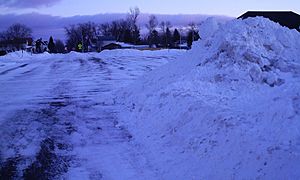
Ashland is located along the south shore of Chequamegon Bay. According to the United States Census Bureau, the city has a total area of 13.70 square miles (35.48 km2), of which 13.42 square miles (34.76 km2) is land and 0.28 square miles (0.73 km2) is water.
Climate
There are four distinct seasons, with notably cold winters. Due to its proximity to Lake Superior, lake effect snow is sometimes a phenomenon in Ashland.
Demographics
| Historical population | |||
|---|---|---|---|
| Census | Pop. | %± | |
| 1890 | 9,956 | — | |
| 1900 | 13,074 | 31.3% | |
| 1910 | 11,594 | −11.3% | |
| 1920 | 11,334 | −2.2% | |
| 1930 | 10,622 | −6.3% | |
| 1940 | 11,101 | 4.5% | |
| 1950 | 10,640 | −4.2% | |
| 1960 | 10,132 | −4.8% | |
| 1970 | 9,615 | −5.1% | |
| 1980 | 9,115 | −5.2% | |
| 1990 | 8,695 | −4.6% | |
| 2000 | 8,620 | −0.9% | |
| 2010 | 8,216 | −4.7% | |
| 2019 (est.) | 7,843 | −4.5% | |
| U.S. Decennial Census | |||
2010 census
As of the census of 2010, there were 8,216 people, 3,516 households, and 1,942 families residing in the city. The population density was 612.2 inhabitants per square mile (236.4/km2). There were 3,864 housing units at an average density of 287.9 per square mile (111.2/km2). The racial makeup of the city was 87.0% White, 0.5% African American, 7.5% Native American, 0.5% Asian, 0.5% from other races, and 4.0% from two or more races. Hispanic or Latino of any race were 2.1% of the population.
There were 3,516 households, of which 26.6% had children under the age of 18 living with them, 37.7% were married couples living together, 12.6% had a female householder with no husband present, 4.9% had a male householder with no wife present, and 44.8% were non-families. 36.7% of all households were made up of individuals, and 14.4% had someone living alone who was 65 years of age or older. The average household size was 2.17 and the average family size was 2.81.
The median age in the city was 38.6 years. 21% of residents were under the age of 18; 13% were between the ages of 18 and 24; 23.1% were from 25 to 44; 26.7% were from 45 to 64; and 16.3% were 65 years of age or older. The gender makeup of the city was 48.2% male and 51.8% female.
Transportation
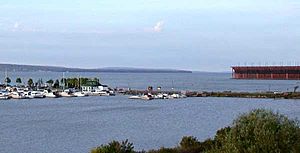
The two major highways in the city are U.S. Highway 2 and Wisconsin Highway 13.
The city is one of the northern termini in Wisconsin for the Canadian National Railway (CN), parent company of the former Wisconsin Central Ltd. It took over the former Soo Line tracks in 1987. However, after flooding in 2016 caused substantial damage to bridges south of town, CN discontinued service to Ashland (trains now reach only as far north as Morse).
Airports
Airports certified for commercial carrier operations near Ashland:
- Gogebic-Iron County Airport (about 54 miles (87 km); Ironwood, Michigan)
- Duluth International Airport (about 92 miles (148 km); Duluth, Minnesota)
- Rhinelander-Oneida County Airport (KRHI) (about 119 miles (192 km); Rhinelander, Wisconsin)
Other public use airports near Ashland:
- John F. Kennedy Memorial Airport (KASX) (about 2 miles (3.2 km); Ashland, Wisconsin)
- Madeline Island Airport (about 17 miles (27 km); La Pointe, Wisconsin)
- Cable Union Airport (about 37 miles (60 km); Cable, Wisconsin)
- Park Falls Municipal Airport (KPKF) (about 58 miles (93 km); Park Falls, Wisconsin)
Public transit
Local transportation is provided by the non-profit Bay Area Rural Transit (BART) system, which has bus stops throughout the community. Headquartered in Ashland's Industrial Park, BART also provides transportation to and from other communities in the Chequamegon Bay region, including Washburn, and Bayfield.
Northern Towns Transport is a regional car service and shuttle provider, connecting Ashland and the Chequamegon Bay area with downtown Minneapolis, Minnesota and Minneapolis-St. Paul International Airport; as well as the Twin Ports of Superior, Wisconsin / Duluth, Minnesota and Duluth International Airport.
Arts and culture
The region is served by the Chequamegon Bay Arts Council, a non-profit organization promoting the arts in northern Wisconsin.
The Ashland Chamber Music Society is a volunteer organization that provides a venue for local and regional musicians to perform chamber music in the Ashland area.
The Bay Area Film Society is a group of film enthusiasts who sponsor the screening of classic films.
The Chequamegon Symphony Orchestra (CSO) provides enriching, engaging, and entertaining orchestral concerts to the residents of northern Wisconsin.
Recreation
Natural places in the vicinity include Lake Superior, the Whittlesey Creek National Wildlife Refuge, and the nearby Chequamegon-Nicolet National Forest.
Parks
- Bayview Park, also known as Pamida Beach, contains a swimming beach, bathrooms, fishing pier, picnic area and playground. The 10-mile walking trail that loops Ashland connects to the park. Bayview Park is the only swim front in Ashland that provides lifeguards in the summer.
- Beaser Park
- Kreher Park, also known as Sunset Park, contains 33 RV campsites on lake Superior. The park has a swimming beach, playground, showers, dumping station, and firewood. The park connect to the Ashland Waterfront trail.
- Maslowski Beach features a shallow, sandy swimming beach, playground, pavilion, bathrooms, changing rooms, pay phone and artesian well. There is also access to Ashland's Lake Front Trail along Chequamegon Bay.
- Memorial Park contains a band shell.
- Menard Park
- Prentice Park is the largest of Ashland's 12 parks, at approximately 100 acres. It is a natural habitat for migrating birds, a nesting ground for mute swans, with hiking trails, artesian wells, a picnic area, a children's playground, and tent camping.
Hiking and biking trails
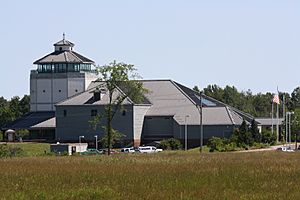
- Tri-County Corridor
- Lakefront Trail, along Lake Superior
- There is a recreational trail that loops around the entire city.
- North Country Trail
Boating
- Ashland Marina, located behind the Hotel Chequamegon
Camping
- RV camping is available at Prentice park, and Kreher Park.
- Tent camping is available at Prentice Park.
Local attractions
- Ashland Historical Museum
- Northern Great Lakes Visitor Center - a regional information center with natural history exhibits. A branch office of the Wisconsin Historical Society is located upstairs.
- The Chequamegon Theatre Association is located in the historic Rhinehart Theatre.
- Ashland Chequamegon Bay Golf Course
Events
- Bay Days is Ashland's annual community festival, held every year in the middle of July. In addition to street vendors and live outdoor music, other happenings include a "Strongest Man in the Bay Contest" and a Sprint Triathlon.
- The Book Across the Bay ski race is held every year in February. The course for the race crosses the frozen Chequamegon Bay of Lake Superior, starting in Ashland, and ending in Washburn.
- The WhistleStop Marathon and half-marathon is held every fall, and draws athletes from surrounding regions. The before-race events include a pasta feed, and live music the night before.
- Live chamber music concerts performed by the Ashland Chamber Music Society
- The annual Red Clay Classics car race held at ABC Raceway
- The Ashland Area Farmer's Market is held in the summer on Saturday mornings.
- Holiday parades include a Fourth of July parade, a Christmas parade, and a Homecoming parade.
- The Ashland County Fair is usually held in September at the fairgrounds in Marengo.
- The Superior Vistas Bike Tour is held in June.
- The Chequamegon Bay Bird & Nature Festival is held in May.
- Garland City Women's Expo is held in November.
- Chick-uamegon 5k & 10k run
Economy
A few of the largest manufacturers in the community include:
- Bretting Manufacturing, equipment manufacturer
- Larson-Juhl, manufacturer of picture frames, a subsidiary of Berkshire Hathaway
- H Windows, window manufacturer
Many small businesses also make up a large portion of the local economy. Tourism is an important part of the area's commerce. The summer season attracts tourists for activities on the Great Lakes.
Education

Public schools
- Lake Superior Primary/Intermediate/Charter School
- Marengo Valley Elementary School
- Ashland Middle School
- Ashland High School/Ashland Charter High School
Private schools
- Ashland Seventh-day Adventist School
- Celebration Christian Academy
- Our Lady of the Lake School
- Zion Lutheran Christian School
Colleges
- Northland College
- Wisconsin Indianhead Technical College
Notable people
- Ove H. Berg, Wisconsin State Representative
- Janet Bewley, member of the Wisconsin Legislature
- Abe L. Biglow, Wisconsin State Representative
- Bob Blake, NHL player
- Bob Brevak, racing driver
- F. Taylor Brown, U.S. Navy admiral
- Ray Callahan, MLB pitcher for the Cincinnati Reds
- John C. Chapple, Wisconsin State Representative and newspaper editor
- Moose Cochran, NFL player
- Norm DeBriyn, former head coach of the Arkansas Razorbacks baseball team
- Sean Duffy, U.S. Congressman
- Sam Fifield, 14th Lieutenant Governor of Wisconsin, and noted businessman
- Moose Gardner, professional football player
- Bernard E. Gehrmann, Wisconsin State Representative
- Jack Hall, labor organizer and trade unionist
- Morgan Hamm, Olympic medalist
- Paul Hamm, world champion gymnast, Olympic gold medalist
- Everis A. Hayes, U.S. Representative from California
- Andrew R. Johnson (1856–1933), Louisiana state senator from 1916 to 1924 and mayor of Homer, Louisiana, lived in Ashland while working in the 1890s for the United States Land Office. In 1901, he named the village of Ashland, Louisiana, for Ashland, Wisconsin.
- John Kingston, Jr., Wisconsin State Senator
- Jim Kisselburgh, football player
- Clarence A. Lamoreux, Wisconsin State Senator
- Lawrence A. Lamoreux, Wisconsin State Assembly
- William D. Leahy, U.S. Navy Fleet Admiral, first military officer to reach a five-star rank; Chief of Naval Operations; Governor of Puerto Rico; U.S. Ambassador to France; White House Chief of Staff for Franklin D. Roosevelt and Harry S. Truman
- Michael A. McAuliffe, U.S. Air Force Brigadier General
- Robert Bruce McCoy, U.S. National Guard Major General
- George F. Merrill, Wisconsin State Senator
- Jennifer Ouellette, Science Writer
- Sigurd F. Olson, author
- William Plizka, member of the Wisconsin Legislature
- Joe Rogalski, MLB player
- Albert W. Sanborn, Wisconsin State Senator
- John C. Sibbald, Wisconsin State Representative
- John W. Slaby, Wisconsin State Representative
- Dave Suminski, NFL player
- John Szarkowski, photographer
- Justus Smith Stearns, businessman
- Daniel Theno, Wisconsin State Senator, Ashland Mayor
- A. Pearce Tomkins, Wisconsin State Senator
- Harry P. Van Guilder, Wisconsin State Representative
Images for kids
See also
 In Spanish: Ashland (Wisconsin) para niños
In Spanish: Ashland (Wisconsin) para niños


